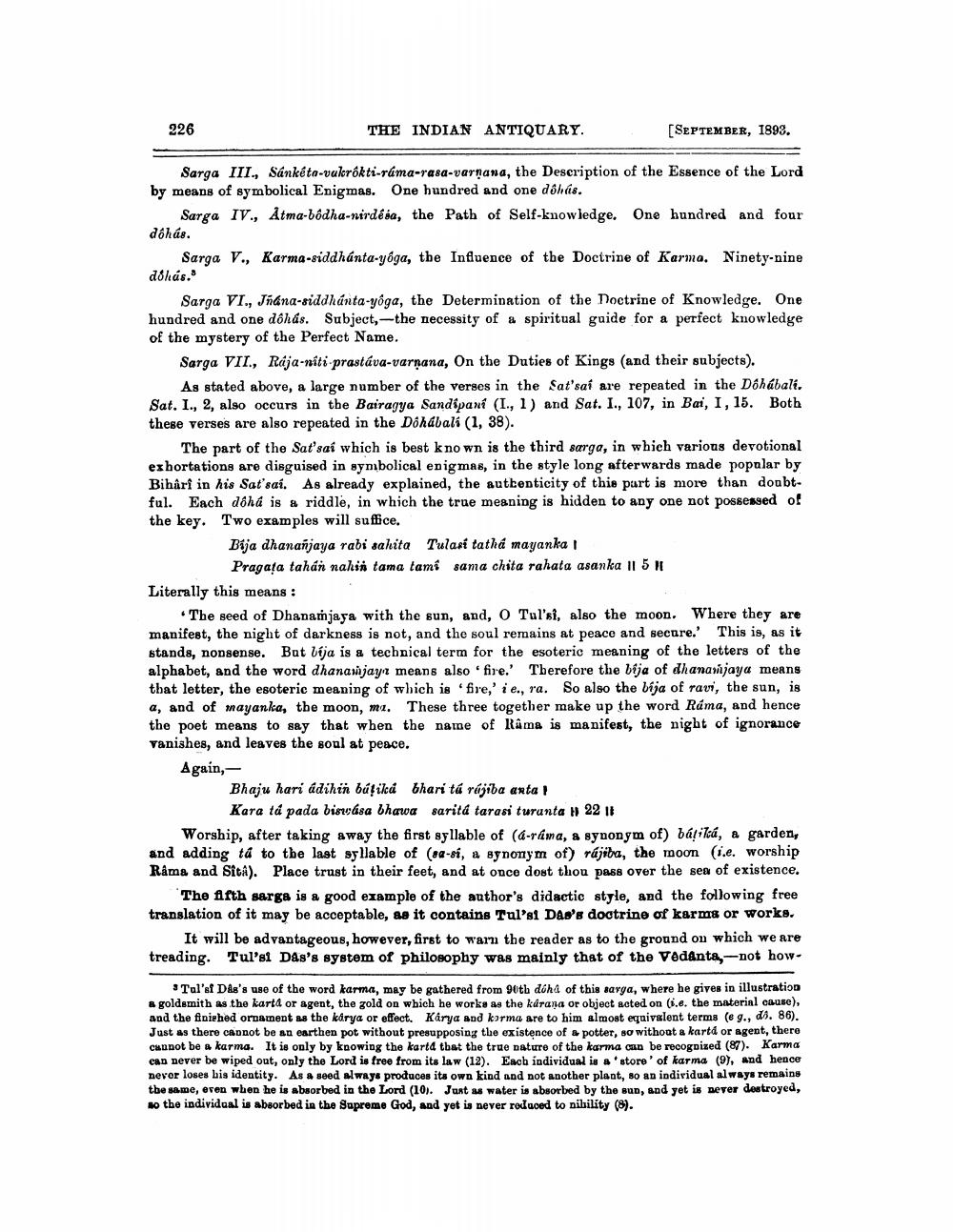________________
226
THE INDIAN ANTIQUARY.
[SEPTEMBER, 1893.
Sarga III., sánkéta-vukrókti-rama-rasa-varnana, the Description of the Essence of the Lord by means of symbolical Enigmas. One hundred and one dihas.
Sarga IV., Atma-bódha-nirdésa, the Path of Self-knowledge. One hundred and four dóhás.
Sarga V., Karma-siddhanta-yôga, the Influence of the Doctrine of Karma. Ninety-nine dohás.
Sarga VI., Jñana-siddhanta-yoga, the Determination of the Doctrine of Knowledge. One hundred and one dôlás. Subject, -the necessity of a spiritual guide for a perfect knowledge of the mystery of the Perfect Name.
Sarga VII., Raja-niti prastáva-varnana, On the Duties of Kings (and their subjects).
As stated above, a large number of the verses in the Sat'sai are repeated in the Dôhábali. Sat. I., 2, also occurs in the Bairagya Sandipani (I., 1) and Sat. I., 107, in Bai, I, 15. Both these verses are also repeated in the Dóndbali (1, 38).
The part of the Sat'sai which is best known is the third sarga, in which various devotional exhortations are disguised in symbolical enigmas, in the style long afterwards made popular by Bihari in his Sat'sai. As already explained, the authenticity of this part is more than doubtful. Each dôhd is a riddle, in which the true meaning is hidden to any one not possessed of the key. Two examples will suffice.
Bija dhananjaya rabi sahita Tulari tatha mayanka!
Pragața tahán nahin tama tami sama chita rahata asanka 115 Literally this means :
• The seed of Dhanamjaya with the sun, and, O Tul'si, also the moon. Where they are manifest, the night of darkness is not, and the soul remains at peace and secure. This is, as it stands, nonsense. But lija is a technical term for the esoteric meaning of the letters of the alphabet, and the word dhananjay means also "fire. Therefore the bija of dhanawijaya means that letter, the esoteric meaning of which is fire,' i e., ra. So also the bija of ravi, the sun, is a, and of mayanka, the moon, mi. These three together make up the word Ráma, and hence the poet means to say that when the name of Rama is manifest, the night of ignorance vanishes, and leaves the soul at peace. Again,
Bhaju hari adihin búfilcá bhari tá rájiba anta!
Kara tá pada biswasa bhawa sarita tarasi turunta # 22 11 Worship, after taking away the first syllable of (a-rama, a synonym of) báliká, a garden, and adding ta to the last syllable of ($-81, a synonym of) rájiba, the moon (i.e. worship Rama and Sita). Place trust in their feet, and at once dost thou pass over the sea of existence.
The fifth sarga is a good example of the author's didactic style, and the following free translation of it may be acceptable, as it contains Tul'si Das's doctrine of karms or works.
It will be advantageous, however, first to warn the reader as to the ground on which we are treading. Tul'si Das's system of philosophy was mainly that of the Vedanta, -not how
Tal'si DÅs's use of the word karma, may be gathered from 90th dóha of this sarga, where he gives in illustration & goldsmith as the karta or agent, the gold on which he works as the kårana or object acted on (i.e. the material cause), and the finiehed ornament as the karya or effect. Karya and karma are to him almost equivalent terms ( g., ds. 86). Just as there cannot be an earthen pot without presupposing the existence of potter, so without a kartd or agent, there cannot be a karma. It is only by koowing the kartų that the true nature of the karma can be recognized (87). Karma can never be wiped out, only the Lord is free from its law (12). Each individual is a store' of karma (9), and hence nevor loses his identity. As & seed always produces its own kind and not another plant, so an individual always remains the same, even when he is absorbed in the Lord (10). Just as water is absorbed by the sun, and yet is never destroyed, so the individual is absorbed in the Supreme God, and yet is never rodaoed to nibility (8).




